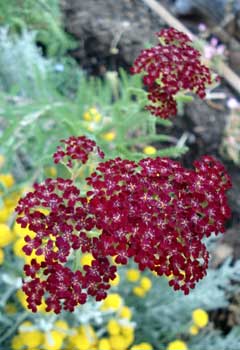
'Royal Tapestry' Yarrow
"Green, country herbs, they say, will staunch a wound,
And I have run about the fields & gathered
Those I could catch up quickly."
-Michael Field
(pseudonym of Katherine Bradley, 1846-1914,
& Edith Cooper, 1862-1913)
Often pictorial plant labels exaggerate the beauty of a flower, which never looks quite that perfect in the garden. A larger than average picture-label for the Garden Bloomers-distributed Achillea millefolium 'Royal Tapestry' showed a pink & maroon flower that was nice enough looking, but what burst forth in our garden was an intensely burgundy blossom way cooler than the photograph had promised! And how lovely to get more than one's promised for a change.(pseudonym of Katherine Bradley, 1846-1914,
& Edith Cooper, 1862-1913)
It is, however, really only a twin for 'Summerwine,' which if planted side-by-side with 'Royal Tapestry' are completely indistinguishable. Both are great looking blooms but I do begin to wonder sometimes if this notion of "new" cultivars isn't sometimes Malarkey, Hooey, & Balderdash, which I'm voting as names for the next three cultivar alleging to be brand new.
The intense burgundy or royal purple does fade as the long-lasting flower ages to lavender-pink & pinkish-white, for the white "eye" at first a pinpoint widens. It's typical of colorful yarrows to go through color changes, with newer blooms having the initial color simultaneous with the older blooms shifting to new shades.
It blooms as early as June, until about September, & is at its height of blossom July & August. Taking cuttings for bouquets, & pruning off spent flowers, helps keep it reblooming.
Its first year in the ground it will need to be watered fairly regularly, though it's healthy to let it briefly dry out between waterings. Once established it is fairly drought tolerant, but for the longest hottest driest days of summer some water needs to be gotten to it each dayi, or it just won't look as nice.
It's cold-hardy to zone 3, though harsh conditions can do it in during its dormancy if too wet, too frozen, or in summer too awfully dry for too long. It perenializes most winningly in zones 5 through 8.
Two feet or a bit taller, it rarely lodges (tips over). The clump slowly spreads wider & wider, eventually needing to be dug up & divided, ideally late in autumn when at long last it stops blooming. Where there is only a mild winter (such as we experience in Zone 8), it's fine to divide them late winter or early spring.
The basal leaves are semi-evergreen in our zone, but if it does vanish utterly at some point in the winter, it generally returns good as new when weather warms a bit, as a chill is not apt to kill it, though excess winter wetness can. Where winter rainfall is persistent, a raised bed is a benefit. Doing well as a container plant, if containers can be dragged under the eaves or to a cool shelter during the rainiest days of winter, that can be of benefit too. If soils in dthe open garden drain really well, however, these hardy plants won't likely need special attention.
Yarrows rarely look their best if overwatered or in too rich a soil. They like slightly depleted sandy soils, but not alkaline. Sometimes no matter what one does, the tiny ferny leaves get wilty or raggedy looking, & that has to be taken in stride, as this is a flower as humble & rustic as it is persistently showy for summer & autumn.
Yarrows have a wide array of common names including Staunchweed, Bloodwort, Soldier's Woundwort, Nosebleed, Achillea, Seven Year's Love, Arrowroot, Sanguinary, Gordaldo, Rajmari, Knyghten, Spreewald, or Carpenter's Weed. Many of its names allude to its use notably among soldiers to staunch the wounds of battle. Names such as Milfoil, Thousand Leaf or Thousand Seal, & Plumajillo (Little-feather), allude to the ferny leaves made up of tinier leaves.
Traditionally, dried leaves & flowers were saved for use as a spice (hence the folkname Old Man's Pepper or Old Man's Mustard) & as a folk-remedy. The "Old Man" meant the devil, for which association yarrow was also called Snake's Grass, Bad Man's Plaything, Deathweed, Eerie, or Devil's Nettles. It was known as Field Hops because it was a major ingredient of gruit used as a beer flavoring or bitters.
As a tea it was credited as a health tonic. It does have many active chemical compounds that cause some people to be allergic to it, & prolongued heavy use of a yarrow tonic can cause photosensitivity & other side-effects. Externally it was used as an astringent & antiseptic. If pressed against wounds it was supposed to stop bleeding & pain & fascilitate healing. The genus name is after the Greek hero Achilles, who learned women's herblore from his mother, & used yarrow on the battlefield to stop the bleeding of warriors' wounds.
In spite of a very mild toxicity (true also of many familiar spices), when used sparingly it is an excellent culinary herb. Dried & crumbled, it's a good substitute for sage. Fresh leaves can be boiled in soups or as with spinach recipes. An extract is sometimes used as a commercial flavoring in beverages.
Continue to:
'Saucy Seduction' Rosy-Pink Yarrow